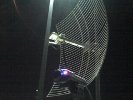|
As a mental exercise (for now), I am looking at setting up a backbone of ~18 point to point links ranging in distance from 5 miles to 35 miles. These links are in remote areas and connect ridgelines/hilltops which make good repeater sites. These sites are typically >=1500 feet above the surrounding terrain. I am interested in determining which links can be served by "regular" FCC Part 15 rules and which need a Ham license. As I understand it, these routers are using digital modulation of a single channel, not "frequency hopping".
I would like to confirm with you all that the big thing I need to pay attention to for Part 15 compliance is 15.247 (c) (1) (i-ii), and 15.247 (b) (3). Specifically, in the 2.4 Ghz band, I need to reduce the maximum power (30dBm) by 1dBm for every 3dBi that the antenna exceeds 6dBi. In the 5GHz band, the maximum power is 30dBm regardless of antenna. So in the 2.4Ghz band, it's the combination of power and antenna which trigger the need to use Part 97 rules. In the 5Ghz band, the need to use Part 97 rules is determined solely by power. Secondly, I would like to get a couple of identical radios and an assortment of antennas to probe the performance on various links. Do you have recommendations as to which radios work best, and/or which antennas perform well with them? Eventually, I will need to investigate performance for an omni antenna at each of the backbone nodes, connecting (probably) to a mobile/transportable high gain antenna. One thing at a time.
Thanks for your advice!!
|
